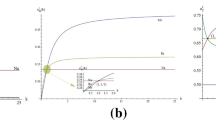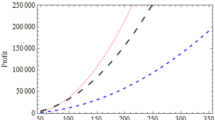Abstract
In this paper, we investigate the optimal advertising strategy for two heterogeneous retailers. To propagandize their products, they have to take the traditional advertising or the targeted one. Then a question appears, what are competitive retailers’ optimal equilibrium advertising strategy when they face with differentiated targeted effect consumers? For that, we design four mutually exclusive models: the traditional advertising for two retailers (the ‘nn’-model); the targeted advertising for one retailer and the traditional advertising for another (the ‘tn’ and the ‘nt’ models); the targeted advertising for both retailers (the ‘tt’-model). First, two retailers engage in Nash game to carry out price competitive under the above four models; then they participate in Stackelberg game to carry out advertising strategy competitive under two different game sequences: Retailer 1 and Retailer 2 as the decision leader respectively. By comparison and analysis, some interesting findings are obtained: when consumers’ expected targeted effect is positive, both retailers benefit from the targeted advertising, and the weaker retailer benefits more than the stronger; the stronger retailer is better off when he is the decision leader than when his competitor is; when consumers’ expected targeted effect is negative and near to zero, its optimal for the dominant retailer to take the traditional advertising and the weaker retailer to take the targeted one; two players get win-win when consumers’ expected targeted effect is low or high enough, and they may fall into lose-lose when consumers’ expected targeted effect is moderate; consumers and social get higher (lower) welfare under ‘tt’-model than under ‘nn’-model when consumers’ expected targeted effect is positive (negative).



























Similar content being viewed by others
References
Bimpikis, K., Ozdaglar, A., & Yildiz, E. (2016). Competitive targeted advertising over networks. Operations Research, 64(3), 705–720.
Brahim, E. B., Lahmandi-Ayed, R., & Laussel, D. (2011). Is targeted advertising always beneficial? International Journal of Industrial Organization, 29(6), 678–689.
Cao, X., & TonyKe, T. (2018). Cooperative search advertising. Marketing Science, 38(1), 44–67.
Casadesus-Masanell, R., & Hervas-Drane, A. (2015). Competing with privacy. Management Science, 61(1), 229–246.
Chandra, A., & Kaiser, U. (2014). Targeted advertising in magazine markets and the advent of the internet. Management Science, 60(7), 1829–1843.
Chen, J., & Jan, S. (2014). An economic analysis of online advertising using behavioral targeting. MIS Quarterly, 38(2), 429–449.
Chiang, W., Chhajed, D., & Hess, J. (2003). Direct marketing, indirect profits: A strategic analysis of dual-channel supply-chain design. Management Science, 49(1), 1–20.
D’Annunzio, A., & Science, M. (2020). Ad networks and consumer tracking. Management Science, 66(11), 5040–5058.
Esteves, R. B., & Resende, J. (2016). Competitive targeted advertising with price discrimination. Marketing Science, 35(4), 576–587.
Gal-Or, E., Gal-Or, R., & Penmetsa, N. (2018). The role of user privacy concerns in shaping competition among platforms. Information Systems Research, 29(3), 698–722.
Galeotti, A., & Moraga-Gonzalez, J. L. (2008). Segmentation, advertising and prices. International Journal of Industrial Organazation, 26, 1106–1119.
Goldfarb, A. (2014). What is different about online advertising? Review of Industrial Organization, 44(2), 115–129.
Gong, Q., Pan, S., & Yang, H. (2019). Targeted advertising on competing platforms. The BE Journal of Theoretical Economics, 19(1), 1–20.
Iyer, G., Soberman, D., & Villas-Boas, J. (2005). The targeting of advertising. Marketing Science, 24(3), 461–476.
Johnson, J. (2013). Targeted advertising and advertising avoidance. The RAND Journal of Economics, 44(1), 128–144.
Lewis, R., & Nguyen, D. (2015). Display advertising’s competitive spillovers to consumer search. Quantitative Marketing and Economics, 13(2), 93–115.
Montes, R., Sand-Zantman, W., & Valletti, T. (2018). The value of personal information in online markets with endogenous privacy. Management Science, 65(3), 1342–1362.
Pei, Z., Paswan, A., & Camp, K. (2020). Valuable strategy and firm performance in the O2O competition. Industrial Marketing Management., 85, 167–179.
Pepall, L., & Reiff, J. (2016). The “Veblen’’ effect, targeted advertising and consumer welfare. Economics Letters, 145(8), 218–220.
Pun, H., & Deyong, G. (2017). Competing with copycats when customers are strategic. Manufacturing & Service Operations Management, 19(3), 403–418.
Rafieian, O., & Yoganarasimhan, H. (2020). Targeting and privacy in mobile advertising. Management Science, 40(2), 193–218.
Selcuk, B., & Özlük, Ö. (2013). Optimal keyword bidding in search-based advertising with target exposure levels. European Journal of Operational Research, 226(11), 163–172.
Shapiro, B. T. (2018). Positive spillovers and free riding in advertising of prescription pharmaceuticals: The case of antidepressants. Journal of Political Economy, 126(1), 381–437.
Shin, J., & Yu, J. (2021). Targeted advertising and consumer inference. Marketing Science, 40(556), 900–922.
Summers, C. A., Smith, R. W., & Reczek, R. W. (2016). An audience of one: Behaviorally targeted ads as implied social labels. Journal of Consumer Research, 43(1), 156–178.
Wang, W., Yang, L., Chen, Y., et al. (2015). A privacy-aware framework for targeted advertising. Computer Networks, 79(14), 17–29.
Zhang, J., & He, X. (2018). Targeted advertising by asymmetric firms. Omega, 89, 136–150.
Zhang, J., Cao, Q., & Yue, X., (2020). Target or Not? Endogenous advertising strategy under competition. IEEE Transactions on Systems, Man, and Cybernetics: Systems, 50(11), 4472–4481.
Zhang, T., Guo, X., Hu, J., et al. (2020). Cooperative advertising models under different channel power structure. Annals of Operations Research, 291(1), 1103–1125.
Acknowledgements
The authors are grateful to the Department Editor, the Senior Editor and the anonymous reviewers for their helpful comments and suggestions. This paper would like to acknowledge the support by the National Natural Science Foundation of China (11771322), the National Natural Science Foundation of China (72102163), the Humanities and Social Sciences Youth Foundation, Ministry of Education of China (20YJC630037).
Author information
Authors and Affiliations
Corresponding author
Additional information
Publisher's Note
Springer Nature remains neutral with regard to jurisdictional claims in published maps and institutional affiliations.
Appendices
Appendix A
Proof A1
For ‘nn’-model, by solving \( \left\{ \begin{array}{c}\frac{\partial \pi _1^{nn}}{\partial p_1}=0\\ \frac{\partial \pi _2^{nn}}{\partial p_2}=0\end{array}\right. \Rightarrow \left\{ \begin{array}{c}p_1^{nn}=\frac{2-2\theta }{4-\theta }\\ p_2^{nn}=\frac{\theta (1-\theta )}{4-\theta }\end{array}\right. \). Substituting them into (4.1), we get \(s_1^{nn}\) and \(s_2^{nn}\). Substituting them into \(s^{nn}=s_1^{nn}+s_2^{nn}\), we otain the total market sale. Substituting \(p_1^{nn},~ p_2^{nn},~s_1^{nn},~ s_2^{nn}\) into (4.2) and (4.3), we get \(\pi _1^{nn}\) and \(\pi _2^{nn}\).
For ‘tn’-model, by solving \(\left\{ \begin{array}{c}\frac{\partial \pi _1^{tn}}{\partial p_1}=0\\ \frac{\partial \pi _2^{tn}}{\partial p_2}=0\end{array}\right. \Rightarrow \left\{ \begin{array}{c}p_1^{tn}=\frac{(2-\theta )(\phi (\alpha +\beta )-\beta )+2(1+f-\theta )}{4-\theta }=\frac{(2-\theta )E+2(1+f-\theta )}{4-\theta } \\ p_2^{tn}=\theta \frac{-\phi (\alpha +\beta )+\beta +1+f-\theta }{4-\theta }=\theta \frac{-E+1+f-\theta }{4-\theta }\end{array}\right. \).
Substituting them into (4.4), we get \(s_1^{tn}\) and \(s_2^{tn}\). Substituting \(p_1^{tn},~ p_2^{tn}\) into (4.5) and (4.6), we get \(\pi _1^{tn}\) and \(\pi _2^{tn}\).
For ‘nt’-model, by solving \(\left\{ \begin{array}{c}\frac{\partial \pi _1^{nt}}{\partial p_1}=0\\ \frac{\partial \pi _2^{nt}}{\partial p_2}=0\end{array}\right. \Rightarrow \left\{ \begin{array}{c}p_1^{nt}=\frac{-\phi (\alpha +\beta )+\beta +f-2\theta +2}{4-\theta }=\frac{-E+f-2\theta +2}{4-\theta } \\ p_2^{nt}=\frac{(\phi (\alpha +\beta )-\beta )(2-\theta )-\theta ^2+2f+\theta }{4-\theta }=\frac{E(2-\theta )-\theta ^2+2f+\theta }{4-\theta }\end{array}\right. \).
Substituting them into (4.7), we get \(s_1^{nt}\) and \(s_2^{nt}\). Substituting \(p_1^{nt},~ p_2^{nt},s_1^{nt},s_2^{nt}\) into (4.8), we get \(\pi _1^{nt}\) and \(\pi _2^{nt}\).
For ‘tt’-model, by solving \(\left\{ \begin{array}{c}\frac{\partial \pi _1^{tt}}{\partial p_1}=0\\ \frac{\partial \pi _2^{tt}}{\partial p_2}=0\end{array}\right. \Rightarrow \left\{ \begin{array}{c}p_1^{tt}=\frac{(E+2)(1-\theta )+3f}{4-\theta }; \\ p_2^{tt}=\frac{(1-\theta )(2E+\theta )+f(\theta +2)}{4-\theta }.\end{array}\right. \). Substituting them into (4.9), (4.10), we get \(s_1^{tt}\) and \(s_2^{tt}\). Substituting \(p_1^{tt},~ p_2^{tt},s_1^{tt},s_2^{tt}\) into (4.11), we get \(\pi _1^{tt}\) and \(\pi _2^{tt}\).
Proof A2
Others are easy to be checked.
Appendix B
Proof B1
-
(1)
When Retailer 1 takes the traditional advertising, \(E\in (\underline{E^{nt}},\overline{E^{nt}})\), Retailer 2 needs to choose from the ‘nt’ and the ‘nn’ models. Because \(\frac{\partial (\pi ^{nt}_2-\pi ^{nn}_2)}{\partial E}>0\), and the zero point of \(\pi ^{nt}_2-\pi ^{nn}_2\) is \(E_3=f+\frac{\theta (1-\theta )}{-2+\theta }+\frac{\sqrt{-f\theta (1-\theta )(4-\theta )^2+\theta ^2(1-\theta )^2}}{2-\theta }\in (\underline{E^{nt}},\overline{E^{nt}})\). Hence, when \(E>E_3\), we have \(\pi ^{nt}_2>\pi ^{nn}_2\), then Retailer 2 takes the targeted advertising; otherwise, she takes the traditional advertising.
-
(2)
When Retailer 1 takes the targeted advertising, because \(\underline{E^{tt}}<\underline{E^{tn}}<\overline{E^{tn}}<\overline{E^{tt}}\), when \(E\in (\underline{E^{tn}},\overline{E^{tn}})\), Retailer 2 needs to choose from the ‘tn’ and the ‘tt’ models. Because \(\frac{\partial (\pi ^{tn}_2-\pi ^{tt}_2)}{\partial E}<0\), and the zero point of \(\pi ^{tn}_2-\pi ^{tt}_2\) is \(E_0=\frac{-2 f + \theta + 3 f \theta - \theta ^2}{-2 + 3 \theta } - \sqrt{\frac{ 32 f \theta - 2 \theta ^2 - 96 f \theta ^2 + 5 \theta ^3 + 90 f \theta ^3 - 4 \theta ^4 - 29 f \theta ^4 + \theta ^5 + 3 f \theta ^5}{(-2 + \theta ) (-2 + 3 \theta )^2}}\in (\underline{E^{tn}},\overline{E^{tn}})\). Hence, when \(E\in (\underline{E^{tn}},E_0)\), \(\pi ^{tn}_2>\pi ^{tt}_2\), then Retailer 2 takes the traditional advertising; otherwise, when \(E\in (\underline{E^{tt}},\underline{E^{tn}})\cup (E_0,\overline{E^{tt}})\), Retailer 2 takes the targeted advertising.
Proof B2
Because \( (-1,\underline{E^{tt}})\) is out of the feasible zone of E under the ‘nt’, ‘tn’ and ‘tt’ models. Hence, Retailer 1 and Retailer 2’s optimal advertising strategy is the ‘nn’-model.
When \(E\in (\underline{E^{tt}},E_3)\), Retailer 1’s needs to choose from ‘nn’ and the ‘tt’-models. Because \(\frac{\partial (\pi _1^{tt}-\pi _1^{nn})}{\partial E}>0\), and the zero point of \(\pi _1^{tt}=\pi _1^{nn}\) is \(E_2=-2+f+\sqrt{4+\frac{f(4-\theta )^2}{-1+\theta }}\in (\underline{E^{tt}},E_3)\). Hence, when \(E\in (E_2,E_3)\), \(\pi ^{tt}_1>\pi ^{nn}_1,\) then Retailer 1 takes the ‘tt’ model. When \(E\in (\underline{E^{tt}},E_2)\), Retailer 1 takes the ‘nn’-model.
When \(E\in (E_3,\underline{E^{tn}})\), Retailer 1 needs to choose from ‘tt’ and ‘nt’-models. It is easy to check that \(\pi _1^{nt}>\pi _1^{tt}\), hence Retailer 1 takes the ‘nt’-model.
When \(E\in (\underline{E^{tn}},E_0)\), Retailer 1 needs to choose from ‘tn’ and ‘nt’-models. It is easy to check that \(\pi _1^{nt}>\pi _1^{tn}\), hence Retailer 1 takes the ‘nt’-model.
When \(E\in (E_0,\overline{E^{nt}})\), Retailer 1 needs to choose from ‘tt’ and ‘nt’-models. Because \(\frac{\partial (\pi _1^{nt}-\pi _1^{tt})}{\partial E}<0\), and the zero point of \(\pi _1^{nt}-\pi _1^{tt}\) is \(E_1=-2+f+\frac{2}{\theta }-\frac{1}{\theta }\sqrt{\frac{(1-\theta )^2(2-\theta )+f\theta (4-\theta )^2(\theta -1)}{-2+\theta }}\in (E_0,\overline{E^{nt}})\). Hence, when \(E\in (E_0,E_1)\), \(\pi _1^{nt}>\pi _1^{tt}\), then Retailer 1 takes the ‘nt’-model. When \(E\in (E_1,\overline{E^{nt}})\), Retailer 1 takes the ‘tt’-model.
When \(E\in (\overline{E^{nt}},\overline{E^{tt}})\), Retailer 1 needs to choose from ‘tt’ and ‘nn’-models. It is easy to check that \(\pi _1^{tt}>\pi _1^{nn}\), hence Retailer 1 takes the ‘tt’-model.
Proof B3
It is easy to prove \(\frac{\partial E_1}{\partial f}=\frac{1}{2} (2 - \frac{(-4 + \theta )^2 (-1 + \theta )}{(-2 +\theta ) \theta \sqrt{\frac{(-1 + \theta ) (8 + 4 (-3 + 4 f) \theta + (4 - 8 f) \theta ^2 + f\theta ^3)}{(-2 + \theta ) \theta ^2}}})>0\), \(\frac{\partial E_2}{\partial f}=1 + \frac{(-4 + \theta )^2}{ 2 \sqrt{\frac{f (-4 + \theta )^2 + 4 (-1 + \theta )}{-1 + \theta }} (-1 + \theta )}>0\), \(\frac{\partial E_3}{\partial f}=1+\frac{(-4+\theta )^2(-1+\theta )\theta }{2(2-\theta )\sqrt{(-1+\theta )\theta (f(-4+\theta )^2+(-1+\theta )\theta )}}>0\). Because \(E_1\), \(E_2\) and \(E_3\) are all negative numbers, then their absolute values decrease along with the increasing of f.
indicate when \(0<f<f_2\), along with f, the speed of move tawards right of \(E_2\), \(E_3\), \(E_1\) are slower and slower; when \(f_2<f<f_0\), the speed of \(E_3\) moving tawards right is the fastest of the three.
Proof B4
We give the proof of \(CS^{1}_{13}\), \(CS^{1}_{22}\)others can be checked through Mathematica. First, according to the definition of \(CS^{1}_{13}\), it is east to be checked that
It is easy to get
By the same way
Proof B5
Because \(\frac{\partial (\pi _1^{tn}-\pi _1^{nn})}{\partial E}>0\) and the zero point of \(\pi _1^{tn}-\pi _1^{nn}\) is \(E_5=\frac{2 - 2 f - 2 \theta + f \theta }{-2 + \theta } + \sqrt{\frac{ 4 - 16 f - 8 \theta + 24 f \theta + 4 \theta ^2 - 9 f \theta ^2 + f \theta ^3}{(-2 + \theta )^2}}\), we get conclusion (1). It is easy to prove that \(\frac{\partial (\pi _1^{tt}-\pi _1^{nt})}{\partial E}>0\) and the zero point of \(\pi _1^{tt}-\pi _1^{nt}\) is \(E_1=-2+f+\frac{2}{\theta }-\frac{1}{ \theta }\sqrt{\frac{-8 + 20 \theta - 16 f \theta - 16 \theta ^2 + 24 f \theta ^2 + 4 \theta ^3 - 9 f \theta ^3 + f \theta ^4}{-2+\theta }}\), we get conclusion (2). We \(E\in (-1,\underline{E^{tt}})\), it is out of the feasible region of E for the ‘nt’, ‘tt’ and ‘tn’-models, retailers has to take the ‘nn’-model, we get conclusion (3).
Rights and permissions
About this article
Cite this article
Li, X., Hou, P. & Zhang, S. The optimal advertising strategy with differentiated targeted effect consumers. Ann Oper Res 324, 1295–1336 (2023). https://doi.org/10.1007/s10479-022-04769-2
Accepted:
Published:
Issue Date:
DOI: https://doi.org/10.1007/s10479-022-04769-2




